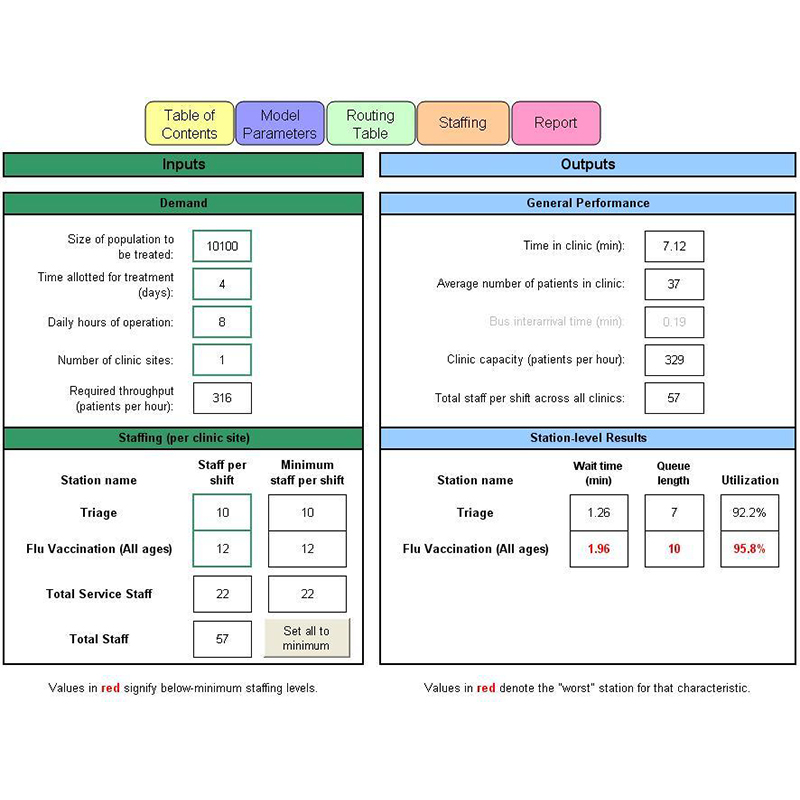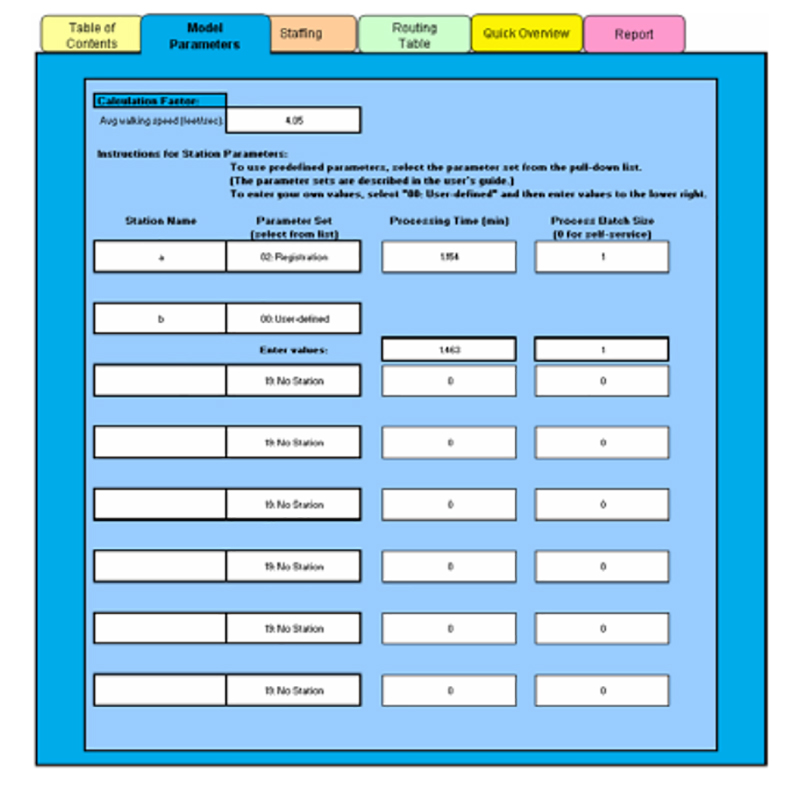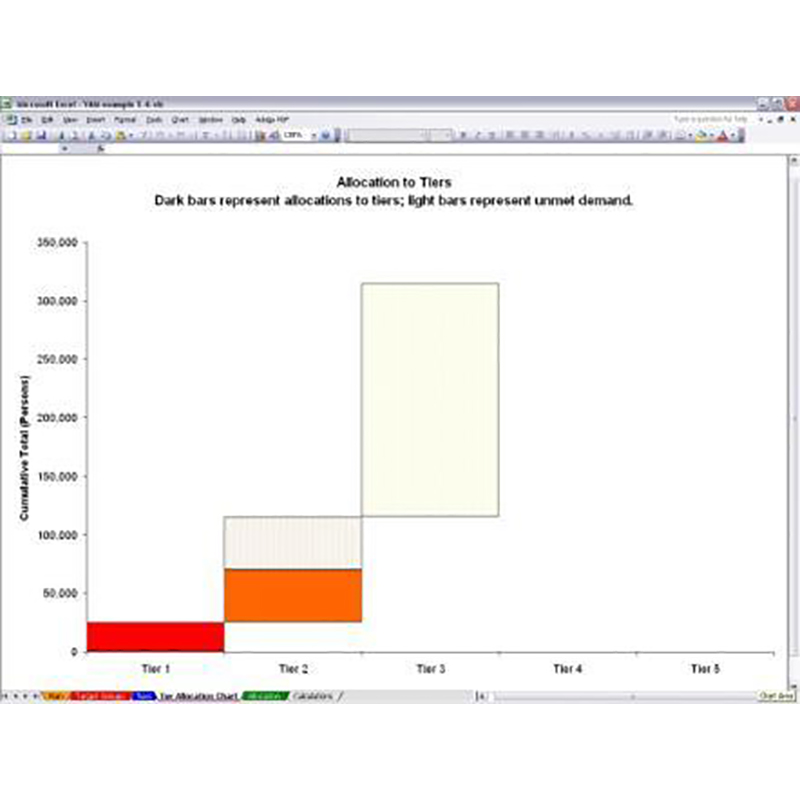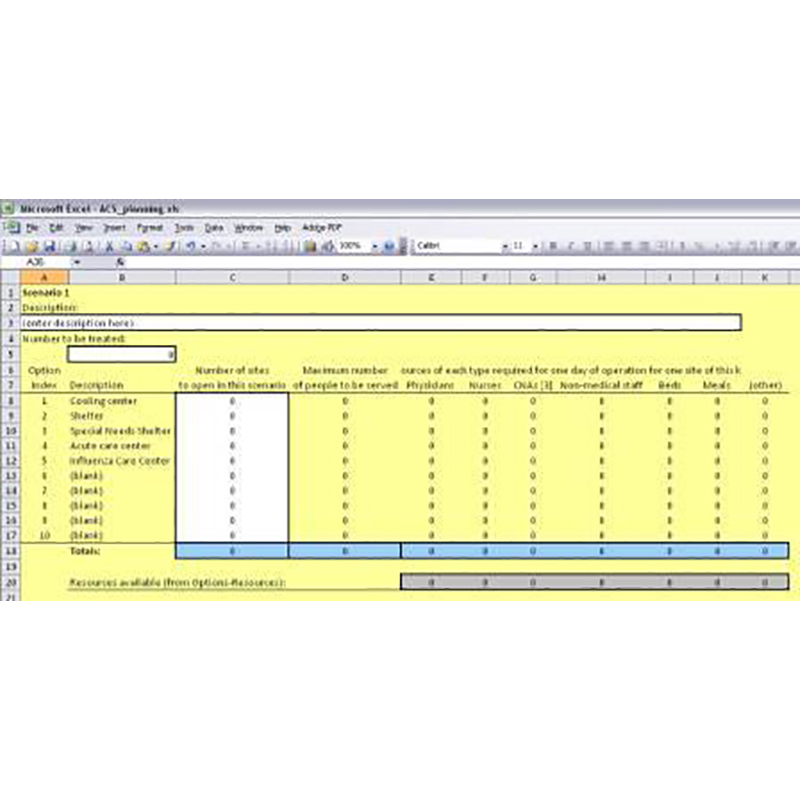Here is a list of computer models that have been developed for public health preparedness activities and are available on-line for use by public health professionals.
Call center operations
Call Center Calculator is a web-based tool that estimates the number the of persons needed to answer calls in order to meet desired customer service levels.
cc-Modeler Lite is software that can determine the number of agents required to handle the incoming call volumes, while maintaining a particular average delay to answer.
Point of dispensing
Bioterrorism and Epidemic Outbreak Response Model (BERM) allows planners to formulate realistic mass antibiotic dispensing and vaccination contingency plans for their target populations. Developed by the U.S. Department of Health and Human Services’ Agency for Healthcare Research and Quality. See also related models by the Cornell Institute for Disease and Disaster Preparedness.
Clinic Planning Model Generator evaluates plans for mass vaccination or dispensing sites (PODs), including estimates of patient waiting time and staff utilization. From Dr. Herrmann at the University of Maryland.
RealOpt includes simulation and optimization modules to determine staffing that optimizes performance in user-defined scenarios. Developed by the CDC and Georgia Tech.
RealOpt Regional identifies the best locations for multiple PODs. From the Center for Operations Research in Medicine and Healthcare at Georgia Tech.
Smallpox
SimPox simulates the spread of smallpox and estimates the number of cases for each day of the attack. Available from Computergestützte Epidemiologie Mathematische Modellierung Simulation.
Pandemic flu tools from the CDC
The U.S. Centers for Disease Control and Prevention has a number of modeling tools available to prepare for pandemic influenza. Their tools page is here.
Community Flu 2.0 is a software program that simulates the spread of influenza through a model community, and the impact of a variety of potential interventions (e.g., vaccinations, school closings, wearing of face masks, patient and household isolation/self quarantine). CommunityFlu also calculates the cost, in terms of workdays lost, of influenza and the associated interventions.
FluAid 2.0 provides a range of estimates of impact in terms of deaths, hospitalizations, and outpatients visits due to pandemic influenza.
FluSurge 2.0 estimates the number of hospitalizations and deaths of an influenza pandemic (whose length and virulence are determined by the user) and compares the number of persons hospitalized, the number of persons requiring ICU care, and the number of persons requiring ventilator support during a pandemic with existing hospital capacity.
FluLabSurge 1.0 is a spreadsheet-based program designed to assist laboratory directors forecast demand for specimen testing during the next influenza pandemic (i.e., the surge in demand), and develop response plans.
FluWorkLoss 1.0 estimates the potential number of days lost from work due to an influenza pandemic.
Influenza Risk Assessment Tool (IRAT) is an evaluation tool developed by CDC and external influenza experts that assesses the potential pandemic risk posed by influenza A viruses that currently circulate in animals but not in humans. The IRAT assesses potential pandemic risk based on two different scenarios: “emergence” and “public health impact.”
Pandemic flu tools created outside the CDC
InfluSim 2.1 predicts the course of an influenza epidemic in a fully susceptible population. Available from Computergestützte Epidemiologie Mathematische Modellierung Simulation.
Vaccine Allocation Model is a Microsoft Excel workbook that can determine how many persons in different target groups can receive treatment if the number of vaccinations available is limited. Available from Dr. Herrmann at the University of Maryland.
Evacuation Planning
Urban to Rural Evacuation Modeling Tool presents statistical data for counties surrounding large cities where evacuations may occur in case of a terrorist attack or other disaster. Available from Penn State.
Casualty Assessment
EMCAPS (Electronic Mass Casualty Assessment and Planning Scenarios) estimates casualties arising from biological (Anthrax, Plague, Food Contamination), chemical (blister, nerve and toxic agents) radiological (dirty bomb) or explosive (IED) attacks. Available from Johns Hopkins University.
RSS Operations
SNS TourSolver is web-based software for use by the Strategic National Stockpile for planning and managing distributions.
Papers focusing on the research in general
-
“Improving Mass Vaccination Clinic Operations,” Kay Aaby, Jeffrey W. Herrmann, Carol Jordan, Mark Treadwell, and Kathy Wood, Proceedings of the International Conference on Health Sciences Simulation, New Orleans, Louisiana, January 23-27, 2005 | summary | PDF |
-
“Simulating Mass Vaccination Clinic Operations,” Kay Aaby, Daniel T. Cook, Jeffrey W. Herrmann, Carol Jordan, and Kathy Wood, working paper, March 15, 2005. | summary | PDF |
-
“Using Operations Research to Improve Mass Dispensing and Vaccination Clinic Planning,” Kay Aaby, Jeffrey W. Herrmann, Carol Jordan, Mark Treadwell, and Kathy Wood, Interfaces, Volume 36, Number 6, pages 569-579, 2006. | summary | PDF |
-
“Embracing Computer Modeling to Address Pandemic Influenza in the 21st Century,” Kay Aaby, Rachel Abbey, Jeffrey W. Herrmann, Mark Treadwell, Carol Jordan, and Kathy Wood, Journal of Public Health Management and Practice, Volume 12, Number 4, pages 365-372, July-August 2006. | summary | PDF |
-
“Disseminating Emergency Preparedness Planning Models as Automatically Generated Custom Spreadsheets,” Jeffrey W. Herrmann, Interfaces, Volume 38, Number 4, pages 263-270, 2008. | summary | PDF |
Papers and book chapters about designing mass vaccination clinics
-
"Design problem decomposition: an empirical study of small teams of facility designers," Gralla, Erica L., Jeffrey W. Herrmann, and Michael Morency, Research in Engineering Design, 2018, doi:10.1007/s00163-018-0300-0. | PDF |
-
"Planning and Managing Mass Prophylaxis Clinic Operations," Abbey, Rachel L., Katherine A. Aaby, and Jeffrey W. Herrmann, in Handbook of Healthcare Operations Management, Brian T. Denton, editor, Springer, New York, 2013.
Papers focusing on the medication distribution problem
-
“Routing and Scheduling for Medication Distribution Plans,” Herrmann, J.W., Sara Lu, and Kristen Schalliol, Technical Report 2008-26, Institute for Systems Research, University of Maryland, College Park, 2008. | summary | PDF |
-
“A Routing and Scheduling Approach for Planning Medication Distribution,” Herrmann, Jeffrey W., Sara Lu, and Kristen Schalliol, Proceedings of the 2009 Industrial Engineering Research Conference, Miami, Florida, May 30-June 3, 2009. | PDF |
-
“Delivery Volume Improvement for Planning Medication Distribution,” Herrmann, Jeffrey W., Sara Lu, and Kristen Schalliol, Proceedings of the 2009 IEEE International Conference on Systems, Man, and Cybernetics, San Antonio, Texas, October 11-14, 2009. | PDF |
-
“Solving the Inventory Slack Routing Problem for Medication Distribution Planning,” Montjoy, Adam, Stephanie Brown, and Jeffrey W. Herrmann, Technical Report 2009-13, Institute for Systems Research, University of Maryland, College Park, September, 2009. | summary | PDF |
-
“Adaptive Large Neighborhood Search for the Inventory Slack Routing Problem,” Montjoy, Adam, and Jeffrey W. Herrmann, Proceedings of the 2010 Industrial Engineering Research Conference, A. Johnson and J. Miller, eds., Cancun, Mexico, June, 2010. | PDF |
-
“Variants of the Adaptive Large Neighborhood Search for the Inventory Slack Routing Problem,” Yan, Zijie, Adam Montjoy, and Jeffrey W. Herrmann, Technical Report 2011-10, Institute for Systems Research, University of Maryland, College Park, September, 2011. | summary | PDF |
-
“Optimizing Urgent Material Delivery by Maximizing Inventory Slack,” Montjoy, Adam, and Jeffrey W. Herrmann, Technical Report 2012-6, Institute for Systems Research, University of Maryland, College Park, June, 2012. | summary | PDF |
Papers focusing on queueing network approximations
-
“Comparing Queueing Software for Mass Dispensing and Vaccination Clinics,” Mark Treadwell, Jeffrey W. Herrmann, Technical Report 2005-113, Institute for Systems Research, University of Maryland, College Park, 2005. | summary | PDF |
-
“Queueing Models and Assessment Tools for Improving Mass Dispensing and Vaccination Clinic Planning,” Mark Treadwell, M.S. Thesis, University of Maryland, College Park, 2006. | summary | PDF |
-
“Constructing Queueing Network Approximations for Mass Dispensing and Vaccination Clinics,” Ali Pilehvar and Jeffrey W. Herrmann, Technical Report 2006-17, Institute for Systems Research, University of Maryland, College Park, 2006. | summary | PDF |
-
“Queueing Network Approximations for Mass Dispensing and Vaccination Clinics,” Ali Pilehvar, M.S. Thesis, University of Maryland, College Park, 2007. | summary | PDF |
-
“Queueing Network Approximations for Mass Dispensing and Vaccination Clinics,” Ali Pilehvar and Jeffrey W. Herrmann, Technical Report 2008-2, Institute for Systems Research, University of Maryland, College Park, 2008. | summary | PDF |
Copyright notice: The papers listed are copyrighted. Personal use of this material is permitted. However, permission to reprint or republish this material for advertising or promotional purposes or for creating new collective works for resale or redistribution to servers or lists or to reuse any copyrighted component of this work in other works must be obtained from the copyright holder.
PowerPoint presentation slides from the 2009 Public Health Preparedness Summit
“Preparing for Emergencies and Every Day: Planning with Computer Models,” Aaby, Kay; Rachel Abbey; and Jeffrey W. Herrmann; San Diego, Calif., Feb. 18, 2009. | PDF of the presentation slides |
Dr. Herrmann's book about general decision making and risk management
Engineering Decision Making and Risk Management, published by Wiley in 2015, emphasizes practical issues and examples of decision making with applications in engineering design and management. In the book, Herrmann presents and discusses three perspectives on decision making: problem solving, the decision-making process and decision-making systems. He highlights formal techniques for group decision making and game theory and includes numerical examples to compare and contrast different quantitative techniques. Herrmann also emphasizes the importance of initially selecting the most appropriate decision-making process through practical examples and applications that illustrate a variety of useful processes. The book also features theoretically sound and practical tools and examples for decision making under uncertainty from the perspective of both historical and current events.
A book on using models for homeland security, edited by Dr. Herrmann
Handbook of Operations Research for Homeland Security, Herrmann, Jeffrey W., editor, Springer, New York, 2012. The book addresses the state of the art in the application of operations research models to problems in preventing terrorist attacks, planning and preparing for emergencies, and responding to and recovering from disasters. The book will enlighten policy makers and decision makers about the power of operations research to help organizations plan for and respond to terrorist attacks, natural disasters, and public health emergencies, while at the same time providing researchers with one single source of up-to-date research and applications.
A 2011 seminar video of Dr. Herrmann talking about this project. (approximately 1 hour)
A 2011 interview with Dr. Herrmann on using models in public health preparedness planning with Betsy Rebert of the Montgomery County APC. (approximately 4 minutes)
Preparing for a Pandemic. Dr. Herrmann is interviewed by Randy Atkins for the Engineering Innovation Podcast and Radio Series, National Academy of Engineering, WTOP, May 10, 2009. (audio only, about 1 minute)
Principal Investigator
Jeffrey W. Herrmann, Ph.D.
Professor
Department of Mechanical Engineering and Institute for Systems Research
University of Maryland
Contributors
The following students have contributed to the success of this project:
-
Abbas Bader
-
Jithesh Balakrishnan
-
Kevin Barrett
-
Vikram Bhandari
-
Brad Brochtrup
-
Stephanie Brown
-
Daniel Tyson Cook
-
Samuel Fomundam
-
Kristen Gaska
-
Kirsten Gheen
-
Franklin Gonzales
-
Will Howell
-
Peyman Karimian
-
Savita Lal
-
Peter Lin
-
Sara Lu
-
Sony Mathew
-
Adam Montjoy
-
Ali Pilehvar
-
Tenaya Prince
-
Varun Santosh
-
Kristen Schalliol
-
Brandon Schein
-
Sandip Southeval
-
Nicole Thomas
-
Mark Treadwell
-
Zijie Yan
Special thanks to Caleb Strockbine, from the University of Maryland Office of Information Technology, for his help with eMedCheck for iOS.
Research sponsors
-
The Montgomery County, Maryland, Advanced Practice Center for Public Health Emergency Preparedness and Response
-
U.S. Centers for Disease Control and Prevention (CDC)
-
National Association of County & City Health Officials (NACCHO)
Acknowlegment and Disclaimer: The material in this project was produced under the direction of the Montgomery County, Maryland Advanced Practice Center at Montgomery County, Maryland Department of Health and Human Resources and was supported by Award Number 1H75TP000309-01 from the Centers for Disease Control and Prevention (CDC) and the National Association of County & City Health Officials (NACCHO). Its contents are solely the responsibility of Montgomery County, Maryland Advanced Practice Center and do not necessarily represent the views of CDC or NACCHO.




